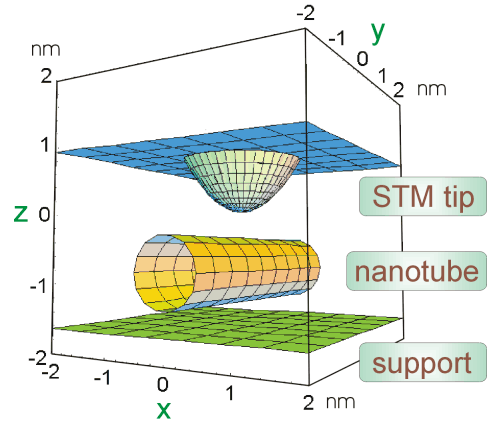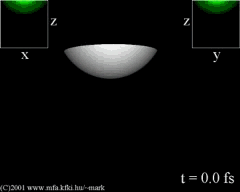
Nanostructures LaboratoryKFKI MFA Budapest |
Click here to receive EMail notification about new uploads to these pages |
| Introduction | Model potential | Results | Animation | Acknowledgments | Links | References |
These results were presented in the IWEPNM2001
conference.
Click here
for details!
 |
Model system used in the calculation. The carbon nanotube is modeled by a cylinder of 0.5 nm radius floating above the support plane at a distance of 0.335 nm. The STM tip is taken as a hyperboloid of 0.5 nm apex radius. The tip/nanotube tunnel gap is 0.4093 nm. |
Snapshots of the probability density of the wave packet approaching
the STM junction from the tip bulk and tunneling through the nanotube into
the support.
(Click on each image to see a larger version!)
Constant density
surface is clipped at the presentation box boundaries. The color scaled
insets are X-Z (perpendicular to the tube) and Y-Z (along the tube) plane
cuts of the density.
 |
This GIF animation (size 1.5 M) shows the time development of a constant
probability density surface clipped at the presentation box boundaries.
Click here to see larger version in MPEG format (size 1.4 M). Click here to see larger version in DivX AVI (MPEG-4) format (size 4.2 M). The driver is available here. |
Márk,Géza,I.;Biró,László,P.;Gyulai,József:
Simulation of STM images of 3D surfaces and comparison with
experimental data: carbon nanotubes;
Phys.Rev.B 58, 12645(1998)
http://ojps.aip.org/journal_cgi/getabs?KEY=PRBMDO&cvips=PRBMDO000058000019012645000001&gifs=No
Márk,Géza,I.;Biró,László,P.;Gyulai,József:;Thiry,Paul,A.;Lucas,Amand,A.;Lambin,Philippe:
Simulation of scanning tunneling spectroscopy
of supported carbon nanotubes;
Phys.Rev.B 62, 2797(2000)
http://ojps.aip.org/journal_cgi/getabs?KEY=PRBMDO&cvips=PRBMDO000062000004002797000001&gifs=Yes